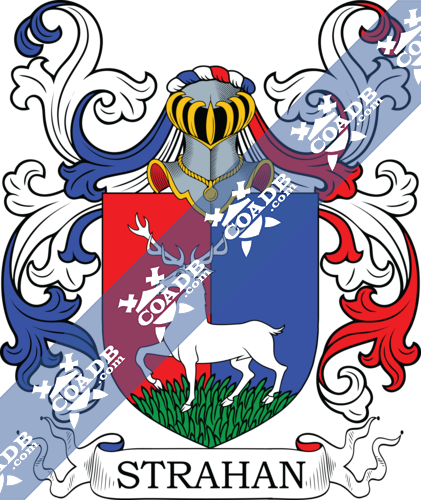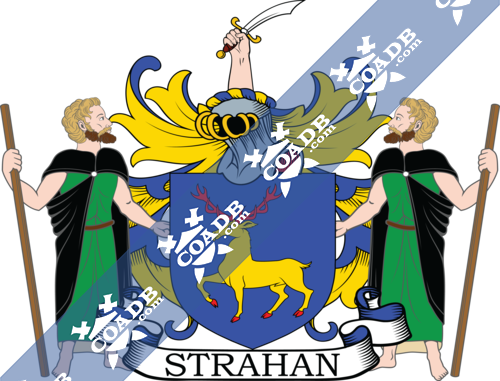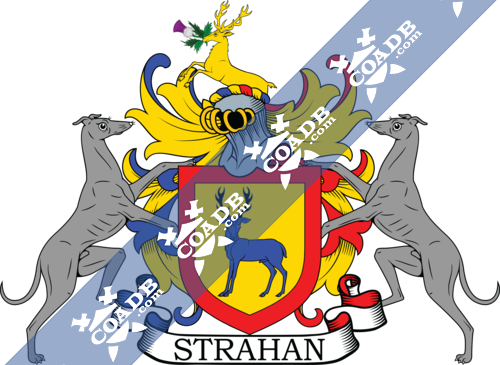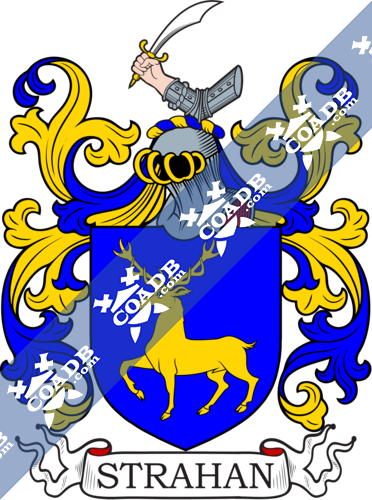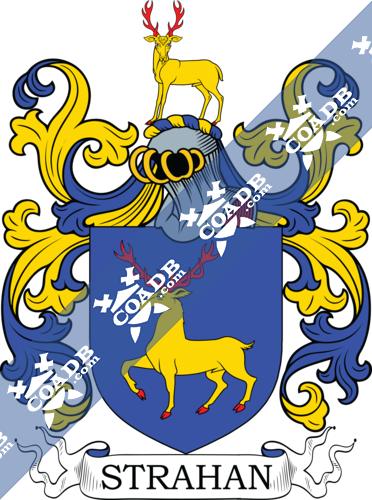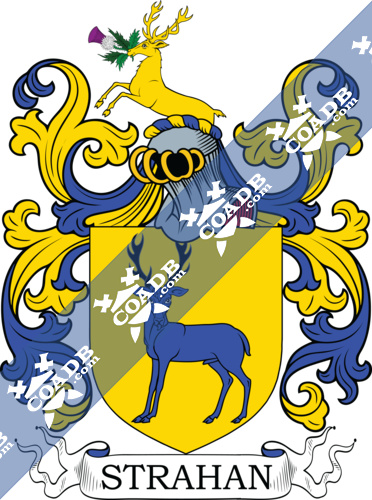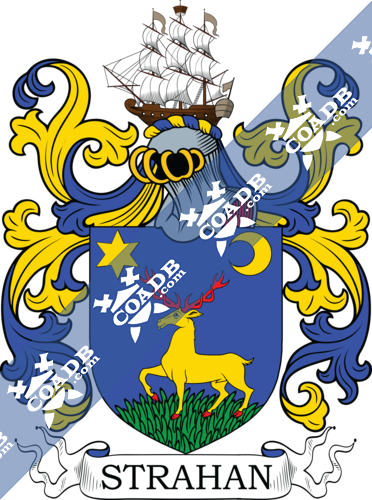Strahan Family Crest, Coat of Arms and Name History
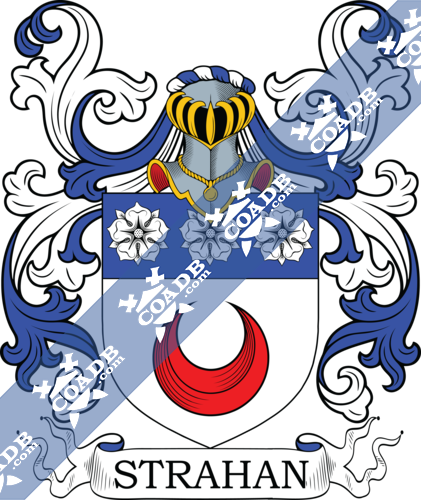
Strahan Coat of Arms Gallery
Don’t know which Coat of Arms is yours?
We can do a genealogical research. Find out the exact history of your family!
Learn MoreStrahan Origin:
Scotland
Origins of Strahan:
This interesting and unique name is of Scottish regional origin, from the estates of Strachan which marked as “Strawn” in Kincardineshire. The name acquires from the Gaelic word “stath” which means a valley or dale, and the word “eachain,” the shortened form of “each” which means a horse so, the whole meanings of the name are “the dale of the horses.” The surname from this origin first was listed at the convocation of the 13th Century. The spellings of the name are “Stratheuchin” in the year 1203, in the “Records of Aberbrotoc Abbey” and Strahechen near the year 1220 in Dunfermline. The spelling Strahin shows in the year 1494, and 1512 one, David Straughin was the counselor of the Scottish “Nation” at the University of Orleans. In the new phrase, the name has four spelling varaities like Stra(c)han, Straughan in Northumberland and Strain in Northern Ireland. George Strahan (1744 – 1824) was a fellow of Dr. Johnson whom he joined on his death bed.
Variations:
More common variations are: Strayhan, Satrahan, Strauhan, Starahan, Strahann, Strayhoan, Strauahan, Strahin, Strohan, Strihan.
Scotland:
The origins of the surname Strahan found in Kincardineshire, an old division on the northeast beach of the Grampian land of Scotland, and part of the Aberdeenshire assembly region since 1996, where the family sometimes spelled theirs as Strachen or Straughan. The family acquires their name from the Dale of the Aan. The oldest list of the tribe was in 1057 AD when they with King Malcolm Canmore northward in his trial to defeat King MacBeth after his arrogation of the Scottish crown. The tribe Strachan was one of the great tribes, those who took part in the war of Lumphanen, 25 miles west of Aberdeen. Macbeth passed away in the War in August 1057 A.D. MacBeth’s Cairn may still be seen there to this day. After That, it listed in 1165 A.D that a Walderus de Strathecan had wide parts in the estates of Strachan.
The very first recording spelling of the family was shown to be that of Waldeuus de (of) Stratheihan, dated about 1200, given the estates of Blarkerocch to the parish of St. Andrew. It was during the time of King William who was known to be the “The Lion of Scotland,” dated 1165-1214. The origin of surnames during this period became a necessity with the introduction of personal taxation.
Ireland:
Many of the people with surname Strahan had moved to Ireland during the 17th century.
United States of America:
Individuals with the surname Strahan settled in the United States in three different centuries respectively in the 17th, 18th, and 19th. Some of the people with the name Strahan who settled in the United States in the 17th century included Alex Strahan landed in Virginia in the year 1657.
Some of the individuals with the surname Strahan who settled in the United States in the 18th century included David Strahan would eventually settle in Virginia in the year 1701.
The following century saw more Strahan surnames arrive. Some of the people with the name Strahan who settled in the United States in the 19th century included James Strahan landed in New York, NY in the year 1844. John Strahan at the age of 4 and Sally Strahan at the age of 25, both arrived in New York in the same year 1854 during the 19th century.
New-Zealand:
Some of the people with the surname Strahan who settled in New Zealand in the 19th century included George Strahan at the age of 40, Julia Strahan at the age of 39, Margaret Strahan at the age of 11 and Alice Strahan at the age of 9, all arrived in Auckland, New-Zealand aboard the ship “ Berar” in the same year 1873.
Here is the population distribution of the last name Strahan: United States 4,210; England 258; Australia 813; Ireland 136; Canada 37; Scotland 46; New-Zealand 80; Northern Ireland 95; Spain 1; Indonesia 2.
Notable People:
John Strahan was a famous builder, working in Bristol and Somerset in the year 1750.
Jonathan Strahan was an Australian producer and judge.
Major Sir George Strahan was a British colonial officer and administrator of Tasmania.
Michael Strahan was an old American football player for the New York Giants.
William Strahan (publisher), was an old editor To the King.
Freddie Strahan was an old Shelbourne F.C football player from the year 1960 to 1973.
Blazons & Genealogy Notes
1) (Brigton, Scotland, 16th century). Ar. a crescent gu. on a chief az. three roses of the first.
2) (Glenkindie, co. Aberdeen). Az. a stag trippant or, attired and unguled gu. Crest—A stag standing at gaze, as in the arms. Motto—Non timeo, sed caveo.
3) (Thornton, co. Kincardine, bart., 1625; as recorded dr. 1740). Or, a hart at gaze az. attired sa. Orest — A demi stag springing or, holding in his mouth a thistle ppr. Motto—Non timeo, sed caveo.
4) (William Strachan, Counsellor-at-law, London, said to be representative of Thornton, 1766). Az. a staff trippant or, attired and unguled gu. Crest—An arm and hand holding a scymitar bendways ppr. Supporters—Two foresters clothed vert, with capes sa. a belt round their waists and staves in their hands ppr. Motto—Forward.
5) (Inchtuthill, Scotland, bart., 1685). Or, a hart at gaze az. attired sa. a bordure gu. Crest—A demi stag springing or, holding a thistle in his mouth ppr. Supporters (1766)—Two greyhounds ppr. Motto—Non timeo sed caveo.
6) (Leven, co. Fife, 1672). Per pale gu. and oz. on a mount in base vert a stag trippant ar. Motto—Forward.
7) (Tarrie, co. Forfar, 1739). Az. on a mount in base ppr. a stag trippant or, attired and unguled gu. in the dexter chief point a star of six rays, and in the sinister an increscent of the last. Crest—A ship in full sail ppr. Motto—Juvat Deus impigros.

